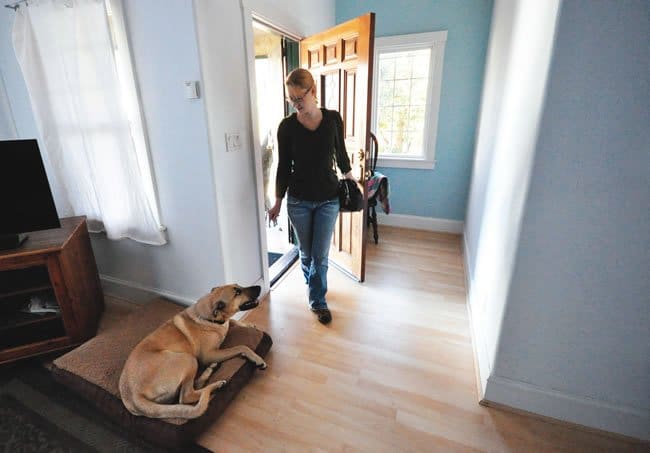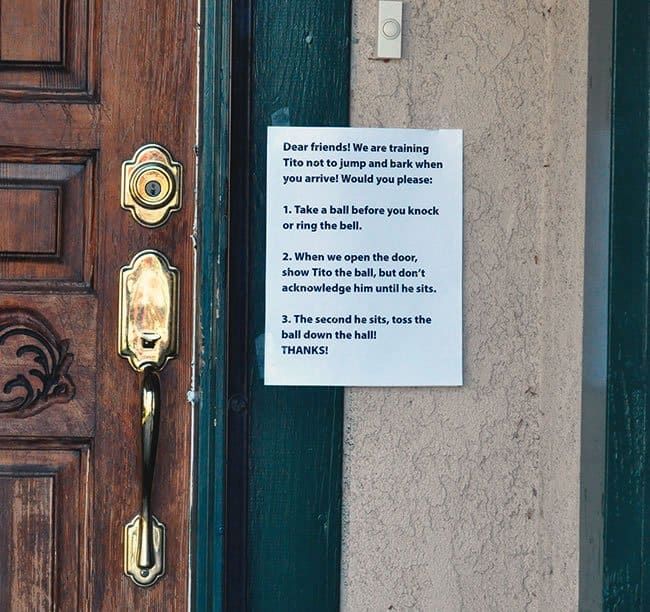Doors are fascinating to dogs. Think about it: Doors are reliable predictors of all kinds of exciting stuff. People enter through doors – people you like and people you don’t like. People leave through doors – people you want to stay, and people you want to go. A door plus a leash equals a WALK! Or maybe a RIDE IN THE CAR! And when the magic door noise happens (whether it’s a doorbell or a knock), the humans often speed to the door and engage in an orgy of greeting rituals guaranteed to be arousing to a dog, including loud voices, handshaking, sometimes even hugging and back-slapping. Small wonder that a significant percentage of dogs develop undesirable door-related behaviors, including:
-
Overly excited greeting of arriving humans
-
Excessive arousal in anticipation of outings
-
Door darting/escaping
-
Aggression directed toward arriving humans
-
Aggression directed toward departing humans
If you are struggling with a dog who exhibits any of these challenging behaviors, take a deep breath and know that you can make it better. The three-step process that follows provides a simple framework to help you modify your dog’s inappropriate door-related behaviors. First we will explain the steps, then look at how to apply them to some of the unwanted behaviors listed above.

Step #1: Visualize/Articulate the Behavior You Want
Old-fashioned training focuses on physically and/or verbally punishing the dog for unwanted behaviors in an attempt to suppress them. While this method can be successful, it carries with it a lot of baggage, including the potential for teaching your dog to fear you, to avoid offering behaviors in training sessions, and to become aggressive in response to the punishment. Obviously, we don’t recommend it.
Modern, positive-reinforcement-based training focuses on the behaviors you want your dog to do. In order to successfully modify an unwanted behavior, you need to start by identifying the desirable behavior(s) you would like your dog to do, instead.
Step #2: Manage the Environment to Prevent Reinforcing Your Dog’s Unwanted Behavior
Management is critical for successful behavior change. Every time your dog is reinforced in some way for an undesirable behavior, it increases the likelihood that he’ll repeat that behavior, and it will be harder to make that behavior go away. (Keep in mind that a “reinforcement” for your dog is not just a tasty treat or word of praise; if anything that your dog enjoys happens as a result of his behavior, – or anything he doesn’t like goes away – it’s a reinforcement. So, if he manages to dart out the door when you open it for someone, and he then gets to run around, or pee, or bark at the UPS truck, he will have been “reinforced” for the door-darting behavior.)
By implementing a well-thought-out management program, you will prevent reinforcement for the unwanted behavior while you install a new behavior in its place. Note that it’s not enough that you don’t reinforce the behavior. You also have to prevent the rest of the world from reinforcing the behavior if you want to change it.
Step #3: Generously Reinforce the Behavior You Do Want
This is where you replace the unwanted behavior with the desired behavior you identified in Step #1. Figure out how to create an environment in which your dog is able to offer the behavior you want so that you have ample opportunity to reward him for it. Behaviors that are consistently reinforced increase, while those that are not reinforced extinguish.
In time, along with the good management you’ve implemented in Step #2, your dog will choose to offer the desired behavior instead of the unwanted one.
Now let’s apply the three-step process to one of our inappropriate door-related behaviors:
EXCITED GREETING OF ARRIVING HUMANS
Step #1: Visualize/articulate the behavior you do want. Here are some possibilities:
- I would like my dog to greet me, other family members, and any visitors at the door (and anywhere else!) by sitting politely in front of them.
- I would like my dog to go lie down on his bed (or go get in his crate) when visitors come to the door.
- I would like my dog to sit for a toy that the visitor holds up and then fetch it when the visitor tosses it.
Step #2: Prevent your dog from being reinforced for the behavior you don’t want.
So, consider the following:
- Use tethers, leashes, crates, baby gates, etc. to restrain your dog and prevent him from happily jumping on people to greet them.
- Instruct family members and visitors to turn away and step away if your dog tries to jump on them.
- Put a note on your front door asking visitors to wait a moment while you put your dog away before answering the door.
Step #3: Generously reinforce the behavior you do want.
In this case, you could try:
- Teach your dog to “Sit politely for greetings.” This is a good-manners behavior best taught to young puppies so they don’t have a strong reinforcement history for jumping up, but it’s never too late to begin.
You can practice polite greetings with your dog on a tether or leash. Step toward him when he’s restrained, and if he starts to jump up, step back. Pet or feed him a treat only if he stays in a polite sit. Don’t ask him to sit; you want him to figure it out himself – otherwise he will sit only when someone asks him to.
If you consistently reward your dog for sitting anywhere and everywhere, sit will become his “default” behavior – he’ll sit whenever he’s not sure what else to do. That’s a good thing!
If company is coming, tether your dog a safe distance from the door so you can greet your guests without worrying about him, and hand them each several treats. Tell them to walk over to greet your dog one at a time, and to pet or feed him only if he remains sitting.
When the initial excitement of the visitors’ arrival subsides, you can remove him from his tether. If necessary, keep him on leash for a bit so he can walk around to greet your guests but you can restrain him if you see him gathering himself to jump up.
When he is settled enough, take him off leash and let him interact freely. Remember to remind your guests to turn their backs if he jumps up!
- Teach your dog to “Lie down on your bed (or go in your crate) when visitors are at the door.” You can teach your dog that the sound of the doorbell, or a knock at the door, is his cue to go lie down on his bed, or run and jump into his crate. Once there you can tether him at his bed or close the crate door, if necessary, to prevent him from running to greet your guests.
If you don’t already have a verbal cue for the behavior you want, begin by teaching him one. Stand two feet away from your dog’s designated spot. Say “Go to bed” (or “Crate” or whatever cue you want to use) and prompt him to go there by pointing and/or using a treat lure. When he gets there, mark the desired behavior with the click of a clicker or a verbal “Yes!” and give him a treat. When he starts heading for his bed or crate upon hearing the cue, fade the prompt/lure by waiting until he gets there, and then using the click and treat.
Gradually increase your starting distance until he will run to his bed/crate from across the room, and farther. When he will go there on just the verbal cue from anywhere in the house, you are ready to add the new cue – the knock and/or sound of the doorbell.
To install the new cue, start with your dog just a few feet from his crate or bed. Make a knocking sound or ring the bell and then give your dog the verbal cue to go to his bed/crate. If he seems confused, go ahead and prompt/lure as needed, until he’s no longer distracted by the knock or bell and begins to realize that it means the same thing as your verbal cue. When he will go to his designated spot consistently from just a few feet away at the sound of the knock or bell, gradually increase distance until he will run there from anywhere in the house at the sound.
Now do setups with people actually coming to the door. Be prepared to follow the knock or doorbell with your verbal cue until he can get past his excitement over someone being at the door and respond promptly and consistently to the cue.
Continue to practice with setups until he will run to his spot upon hearing the knock or bell, even with the exciting stimulus of a stranger at the door.
- Teach your dog to “Sit for and fetch a toy.” This one is my favorite because it’s fun for dog and guests alike. Keep a basket of toys outside your front door, with clear and simple instructions for your visitor to:

1. Take a toy out of the basket before you enter.
2. Hold the toy at your chest and wait for your dog to sit.
3. When he sits, toss the toy 10-15 feet into the house.
4. If he brings it back and drops it or hands it to you, you can wait for him to sit and toss it again, if you want.
Of course, you will have practiced this with your dog ahead of time so you are confident that he knows how to play the game. You may also have to eventually put the toy up so he will stop pestering your guest to throw it again. Unless, of course, your guests are enjoying the game as much as your dog, in which case you can just sit back and let them exercise him for you!
EXCESSIVE AROUSAL IN ANTICIPATION OF AN OUTING
Okay, let’s apply the three-step process to another door-related behavior commonly displayed by dogs. This time, I’ll be brief, in order to streamline the logic of the three steps.
Let’s say your dog gets highly aroused, leaping into the air and bouncing off of you or the door, when you pick up the leash to take him out for a walk. Here’s what you do:
Step #1: Visualize/Articulate the behavior you do want: “I would like my dog to sit calmly and wait for me to attach the leash.”
Step #2: Prevent reinforcement for the behavior you don’t want: As soon as your dog starts acting silly, say, “Oops!” in a cheerful tone of voice and set the leash down. If necessary, turn your back or go sit down until he is calm. Then start the process again. Not only are you preventing reinforcement, you are also telling him that his wild behavior makes the opportunity for a walk go away.
Step #3: Generously reinforce the behavior you do want: When he stays calmly seated for you to attach the leash, reinforce the behavior by opening the door and taking him for that highly anticipated walk. You don’t even need treats to reinforce him for this one – although, of course, you always can reinforce with treats as well.
Your Turn
Now it’s your turn. If your dog has any other undesirable door-related behaviors, take the “three-step process for changing a behavior you don’t like” and give it a go.
But, heck, why limit it to door-related behaviors? You can try it out with any unwanted behaviors your dog exhibits. Try to commit the “three-step process for changing a behavior” to memory so you have it at your fingertips when you need it. Make a list of your dog’s unwanted behaviors in order of importance. Select one or two behaviors from your list and stat applying the “three-step process.” You will be amazed at how quickly those troublesome behaviors can just fly out the door, never to return!







Thank you for your helpful advice. Can’t wait to start using this 3-step plan with my dog!